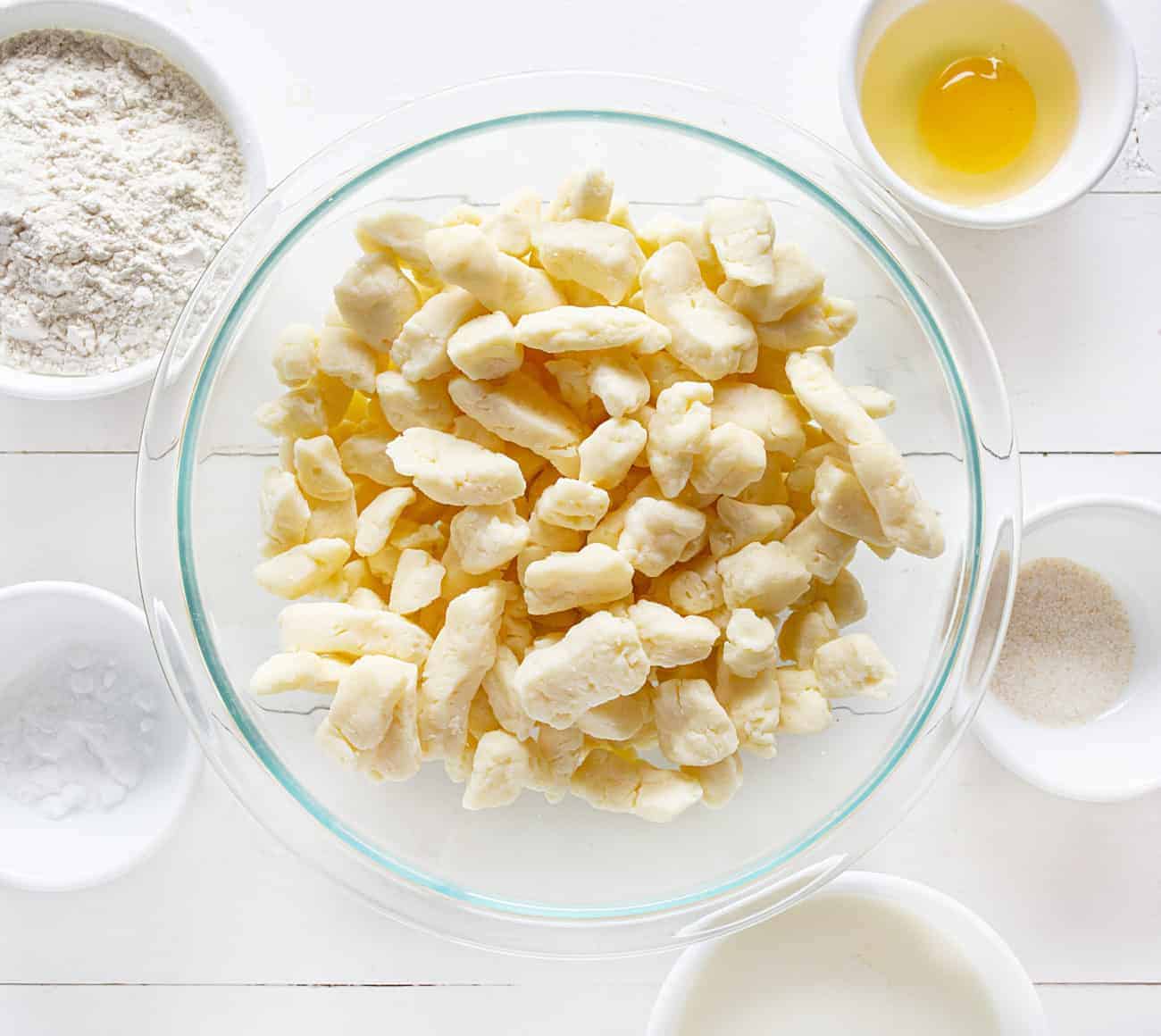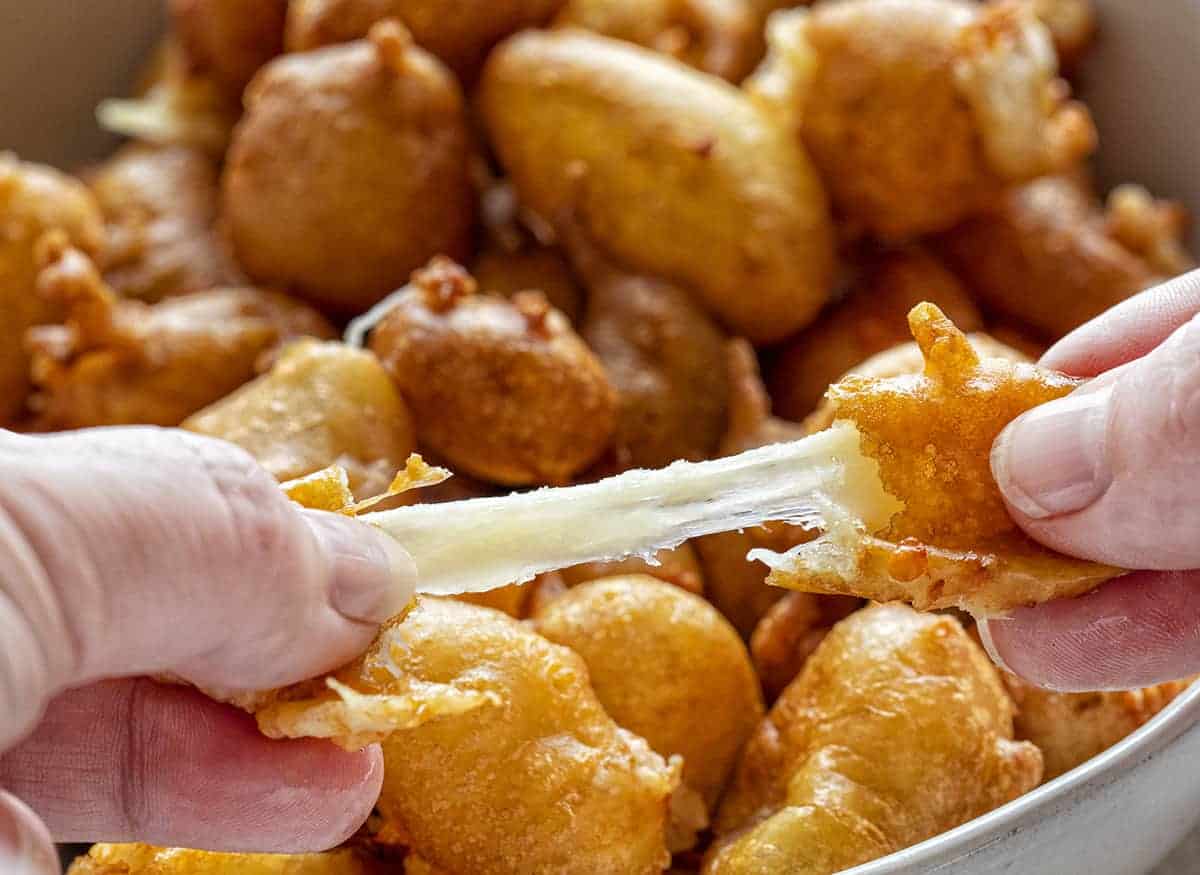Cheese Curds… the BEST thing to ever happen to cheese. These ooey-gooey bite-sized appetizers will literally fly out of the bowl. This cheese curd recipe is super easy to make and tastes even better when dipped in Homemade Ranch Dressing! This recipe is from The Gunny Sack and after all my testing, I know it’s the best!

What are Cheese Curds?
Growing up in the Midwest, I didn’t realize that cheese curds were our thing (the midwest). I thought the entire world was enjoying them. I found out later in life that cheese curds (like REAL cheese curds) were native to the Midwest. The reason that cheese curds are so prominent and so much better here is that cheese curds go hand in hand with dairy farming. Dairy farming is kind of our thing too.
Cheese vs. Cheese Curds
What is the difference between cheese and cheese curds, you may wonder? Well, if you are not from the Midwest, where cheese curds are almost a staple at fairs and bars, it is understandable you may be wondering about the difference.
When milk is heated up, it curdles. This takes place about halfway through the milk to the cheese process. The curds are the pieces of cheddar cheese (white or orange) that don’t make it into the mold and allowed to age and form (which are the flavorful blocks of cheese you buy at the grocery store). A little salt is added to the curds to make it a squeaky snack. Because of this, cheese curds are only fresh for about a day and can be hard to find other than cheese factories.
Besides being popular in the Midwest, you can find them mass-produced in Quebec, where they are a part of their popular Poutine dish. In fact, I used this cheese curd recipe for my Bacon Poutine recipe.

What is the Best Cheese for Cheese Curds?
The best cheese to buy is the freshest cheese. If you have a local cheesemaker or a farmers market, those will be your best bet. Otherwise, take a peek at the label to see when they were produced. Another alternative is to contact a cheesemaker and have them delivered directly to you. In the Midwest, everyone knows that “squeaky cheese” is the freshest. When you bite into a fresh cheese curd you will hear a “squeak” sound. The squeak is a freshness indicator. It comes from the long protein strands that develop inside the cheese. When those protein strands rub against your teeth they emit a squeaking sound. As the cheese continues to age, the strands break down and the squeak starts to fade.
In addition to freshness, you will want to look at what type of cheese you are selecting. The best cheese for fried cheese curds is almost always made from cheddar cheese or white cheddar cheese (which is what I used).

How to Make Cheese Curds
When simple and delicious go together, everyone is happy, am I right? Cheese curds are not hard to make, and that makes them even better in my humble opinion. I have a few tips for making the perfect deep-fried cheese curds.
Watch the Oil
- The oil should be high enough in the pan that the cheese curds are able to be completely covered at all times.
- The temperature of the oil needs to stay as consistent as possible. The optimal temperature for frying cheese curds is 375°F. I like to keep a thermometer in the oil at all times so I can monitor the temperature and adjust as needed.
- Frying too many curds in the pan at once, or not enough curds will affect the oil temperature. I typically fry about 8-10 curds in the pan at a time.
- If you have any leftover oil, don’t throw it out; first, check out How to Clarify Used Cooking Oil so it doesn’t go to waste.
The Batter
- This batter is milk-based. To create it you simply mix a room-temperature egg with buttermilk, flour, garlic salt, and baking soda.
- Some people prefer a beer-based batter. To adjust this recipe to incorporate beer, you can simply swap the buttermilk out for 1 1/2 cups of your favorite beer. Keep in mind that the batter will take on the more prominent flavors of the beer you select. If you choose a beer that is high in hops, that flavor will be present in the final product.
- You can adjust the spice level of the batter by adding a 1/2 teaspoon of cayenne pepper into the mixture. As always, adjust to your liking.
- Most batter recipes need to be used the same day due to the use of raw egg. I would not recommend saving batter for later.

How To Store Cheese Curds
Although best served fresh, store leftovers in an airtight container in the refrigerator. They will last up to 2-3 days. To crisp them up again, reheat them at a low temperature in the oven.
More Appetizers

Cheese Curds
Ingredients
- 2 pounds cheese curds
- 1 ½ cups buttermilk
- 1 ½ cups (187.5 g) all-purpose flour
- 1 teaspoon baking soda
- 2 teaspoons garlic salt
- 1 large egg, room temperature
- 1 ½ quarts canola oil, or more depending on the size of your pan
Instructions
- Heat oil to 375 °F. Use a thermometer to continually monitor the heat of the oil.
- Whisk together buttermilk, flour, baking soda, garlic salt, and egg until smooth.
- Coat 8-10 cheese curds with batter.
- One at a time, add the batter covered cheese curds into the oil. Cook for several seconds, until golden brown and then remove and drain on a paper towel. Repeat with remaining cheese curds.
Video
Notes
- Make sure to use enough oil to completely cover the cheese curds.
- Do not overcrowd the cheese curds in the pan. Ideally, fry 8-10 cheese curds at a time depending on how big your pan is.
- Overcrowding the pan will result in undesirable oil temperatures. Make sure to keep an eye on the oil temperature at all times and adjust the heat if the oil starts to get too hot or too cold.
Did you make this recipe?
Thank you for making my recipe! You took pictures, right? Well go ahead and post them on Instagram! Be sure to mention me @iambaker and use the hashtag #YouAreBaker.















I am going to be making a 2 pound batch of cheese curds this weekend. This recipe looks like a good way to use them.
Hi Amanda
Can I use an air fryer for this recipe?
I don’t recommend it.
Do my cheese curds have to be room temp also?
Did you mention the ratios like how much oil I should use, or did I just miss it?
Where do you find cheese curds.
Many grocery stores (including Walmart and Target) as well as online.
Can you keep them warm in a crockpot to take to a party?
How do you keep the cheese from leaking out?
To minimize cheese leaking out during frying, here are some tips specific to this recipe:
Ensure Proper Coating: Make sure the cheese curds are fully and evenly coated in the batter. Thin spots in the batter can lead to cheese leaking out as it melts.
Keep Oil Temperature Consistent: Maintain the oil at 375°F. If the temperature drops, the batter may not cook quickly enough to seal in the cheese.
Avoid Overcrowding: Frying only 8-10 curds at a time prevents the oil temperature from dropping, ensuring the batter cooks quickly and creates a barrier before the cheese melts too much.
Freeze Curds Briefly: For extra protection, you can place the cheese curds in the freezer for 15-20 minutes before battering and frying. This slows the melting process, giving the batter more time to set.
These steps should help you achieve perfectly fried cheese curds with minimal leaks! 😊
Used this recipe with gluten free flour and it worked amazingly! Best cheese curds I’ve ever had!
Living in the hart of cow country (Wapon,Wisconsin) we know how to judge a cheese curd. That’s why I would recommend this to anyone. It was simply the best I’ve ever tried. This is what I consider better than the finely ground corn flour recipe I have used for years 😋
Excellent! However, I have quite a bit of batter left. Can this be frozen and used again another time?
I’m so glad you enjoyed them! I wouldn’t recommend freezing the leftover batter. Because it contains leavening and dairy, the texture and frying behavior change once it thaws, it won’t coat or puff the same way. 🙁